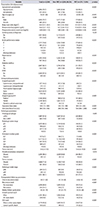1. Rawn J. The silent risks of blood transfusion. Curr Opin Anaesthesiol. 2008; 21:664–668.


3. Acheson AG, Brookes MJ, Spahn DR. Effects of allogeneic red blood cell transfusions on clinical outcomes in patients undergoing colorectal cancer surgery: a systematic review and meta-analysis. Ann Surg. 2012; 256:235–244.

4. Luan H, Ye F, Wu L, Zhou Y, Jiang J. Perioperative blood transfusion adversely affects prognosis after resection of lung cancer: a systematic review and a meta-analysis. BMC Surg. 2014; 14:34.

5. Mavros MN, Xu L, Maqsood H, Gani F, Ejaz A, Spolverato G, et al. Perioperative blood transfusion and the prognosis of pancreatic cancer surgery: systematic review and meta-analysis. Ann Surg Oncol. 2015; 22:4382–4391.


6. Sun C, Wang Y, Yao HS, Hu ZQ. Allogeneic blood transfusion and the prognosis of gastric cancer patients: systematic review and meta-analysis. Int J Surg. 2015; 13:102–110.


7. Xun Y, Tian H, Hu L, Yan P, Yang K, Guo T. The impact of perioperative allogeneic blood transfusion on prognosis of hepatocellular carcinoma after radical hepatectomy: a systematic review and meta-analysis of cohort studies. Medicine (Baltimore). 2018; 97:e12911.
8. Vamvakas EC, Blajchman MA. Transfusion-related immunomodulation (TRIM): an update. Blood Rev. 2007; 21:327–348.


10. Wang YL, Jiang B, Yin FF, Shi HQ, Xu XD, Zheng SS, et al. Perioperative blood transfusion promotes worse outcomes of bladder cancer after radical cystectomy: a systematic review and meta-analysis. PLoS One. 2015; 10:e0130122.

11. Chalfin HJ, Liu JJ, Gandhi N, Feng Z, Johnson D, Netto GJ, et al. Blood transfusion is associated with increased perioperative morbidity and adverse oncologic outcomes in bladder cancer patients receiving neoadjuvant chemotherapy and radical cystectomy. Ann Surg Oncol. 2016; 23:2715–2722.


12. Kim JK, Kim HS, Park J, Jeong CW, Ku JH, Kim HH, et al. Perioperative blood transfusion as a significant predictor of biochemical recurrence and survival after radical prostatectomy in patients with prostate cancer. PLoS One. 2016; 11:e0154918.

13. Pushan Z, Manbiao C, Sulai L, Jun L, Ruidong Z, Hanshen Y. The impact of perioperative blood transfusion on survival and recurrence after radical prostatectomy for prostate cancer: A systematic review and meta-analysis. J Cancer Res Ther. 2018; 14:Supplement. S701–S707.
14. Linder BJ, Thompson RH, Leibovich BC, Cheville JC, Lohse CM, Gastineau DA, et al. The impact of perioperative blood transfusion on survival after nephrectomy for non-metastatic renal cell carcinoma (RCC). BJU Int. 2014; 114:368–374.

15. Tsivian M, Abern MR, Tsivian E, Sze C, Jibara G, Rampersaud EN Jr, et al. Effect of blood transfusions on oncological outcomes of surgically treated localized renal cell carcinoma. Urol Oncol. 2018; 36:362.e1–362.e7.

17. Iwata T, Kimura S, Foerster B, Abufaraj M, Karakiewicz PI, Preisser F, et al. Perioperative blood transfusion affects oncologic outcomes after nephrectomy for renal cell carcinoma: a systematic review and meta-analysis. Urol Oncol. 2019; 37:273–281.


18. Volpe A, Patard JJ. Prognostic factors in renal cell carcinoma. World J Urol. 2010; 28:319–327.


19. Ljungberg B, Bensalah K, Canfield S, Dabestani S, Hofmann F, Hora M, et al. EAU guidelines on renal cell carcinoma: 2014 update. Eur Urol. 2015; 67:913–924.


20. Monk TG, Goodnough LT. Blood conservation strategies to minimize allogeneic blood use in urologic surgery. Am J Surg. 1995; 170:6A Suppl. 69S–73S.


21. Saito J, Masui K, Noguchi S, Nakai K, Tamai Y, Midorikawa Y, et al. The efficacy of acute normovolemic hemodilution for preventing perioperative allogeneic blood transfusion in gynecological cancer patients. J Clin Anesth. 2020; 60:42–43.


22. Abel EJ, Linder BJ, Bauman TM, Bauer RM, Thompson RH, Thapa P, et al. Perioperative blood transfusion and radical cystectomy: does timing of transfusion affect bladder cancer mortality? Eur Urol. 2014; 66:1139–1147.











 PDF
PDF Citation
Citation Print
Print




 XML Download
XML Download